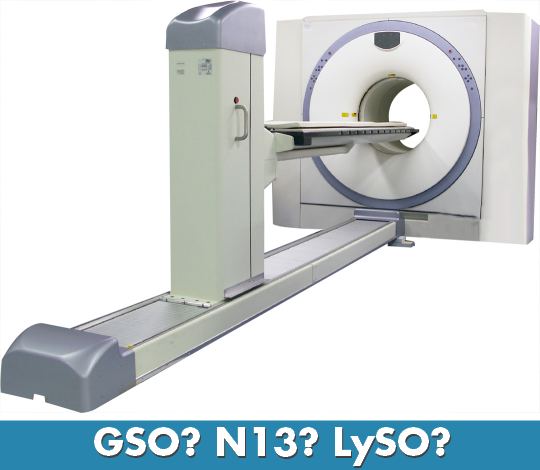
The soup is back from a Holiday break with our PET/CT edition! Read on to have your PET/CT acronyms decoded and defined.
4D: Technology on the CT portion of PET/CTs that not only captures the location of a tumor but also movement over time, useful when treating a tumor located near an organ that moves, sometimes referred to as respiratory gating. (UPMC Cancer Center, 2013)
ACS: Advanced Computational System, computer on a Siemens PET or PET/CT that acquires the image from the scanner, see also, ICS, IRS and PRS.
Attenuation Correction: Siemens software that takes into account the photons a patient absorbs during a study.
Auto MA: Automatic Exposure Control system, featured on GE LightSpeed-based scanners.
AWW: Advantage Windows Workstation, found only on GE product lines, used for post-processing images.
BGO: PET detector made from Bismuth Germinate and formed into a solid crystal, the most common detector on the market.
Cardiac Gating: A component added to a PET or PET/CT used when studying the heart, isolates the images that correspond to the desired point of the heart’s function using ECG signals.
CareDose: Software found on Siemens PET/CT and CTs, used to produce the same image with less radiological dose.
CTA: Coronary CT Angiogram, a specific study performed by the CT component of a PET/CT, 16-slice detectors or, preferably, 64-slice detectors are required to cover the heart region rapidly enough. (The Journal of Nuclear Medicine, 2007)
DLS4, DST, and DSTE: All acronyms for GE’s Discovery PET/CT line, see GE Discovery PET/CT Scanners Compared for more information.
DoseWise: Software found on Philips CTs, used to produce the same image with less radiological dose.
EBW: Extended Brilliance Workstation, Philips PET/CT and CT workstations.
F18: Fluorodeoxyglucose - The most common radiopharmaceutical, primarily used for oncology, commonly known as F-18, or FDG. (Radiological Society of North America, 2004)
FOV: Field of View, the space the radiologist is focusing on when capturing and diagnosing an image.
GSO: PET detector made from Cerium-doped gadolinium silicate, GSO has the lowest atomic number of any detector and can detect across the widest energy spectrum.
HD PET: High Definition PET, uniform high-resolution throughout the field of view, featured on Siemens Biograph PET/CTs.
HiRez: Higher resolution of image quality in PET, accomplished by arranging the detectors in a ring to minimize image noise. (Journal of Nuclear Medicine, 2005)
ICS: Image Construction System, featured on Siemens PET/CT systems, main computer on the CT side.
iDose: Software found on Philips PET/CT, used to produce the same image with less radiological dose.
IRS: Image Reconstruction System, featured on Siemens PET/CT, reconstructs the image with the PET and CT images fused.
LOR: Line of Response, a line along which the positron annihilation was located. (International Atomic Energy Agency, 2009)
LSO: PET detector made from Cerium-doped lutetium oxyerthosilicate, chemical structure of the LSO allows for images to be obtained in less time than BGO.
LySO: PET detector made from lutetium-yttrium oxyorthosilicate, the fastest detectors on the market. (Iran J Nucl Med, 2009)
MHU: Million Heat Unit, refers to the “size” of an X-ray tube, i.e. the tube’s ability to dissipate heat.
N13: Nitrogen-13 Ammonia, an alternative to Rubidium82 for cardiac gated PET and PET/CT studies.
PET: Positron Emission Tomography, shows the function of the body at a cellular level through the various glucose uptake rates of different organs and tissues.
PICO-3D: Electronic component introduced by Siemens on the Biograph line that sped up detection and increased the signal to noise ratio for PET.
PRS: PET Reconstruction System on a Siemens PET/CT.
Rb82: Rubidium82, a byproduct of Strontium that is used in cardiac-gated PET and PET/CT studies.
Scatter Correction: Siemens software feature that rejects scatter to produce a clearer image from a PET or PET/CT.
Syngo©A software solution by Siemens, multi-modality reading and image sharing built on a client-server platform. (Siemens, 2010)
Tc99: Technetium99, a radioactive agent used in PET and PET/CT
TOF: Time of Flight, excellent image quality can be achieved faster (10-30 mins) depending on the size of the patient, makes the biggest difference for the heaviest patients. (J Nucl Med, 2007)
TruePoint: An iteration of Siemens PET/CT models (i.e., Biograph TruePoint) which, according to Siemens, “completely integrates the functional sensitively of PET with the rich anatomical detail of diagnostic multi-slice CT.” (Siemens, 2012)
TrueV: PET/CT software designed by Siemens to increase the PET field of view.
z-UHR: Ultra High Resolution, Siemens proprietary name for .24mm isotropic resolution.
If there’s a common PET/CT acronym we didn’t mention, leave us a comment below so we can expand the information above.

Josh Nunez
Josh Nunez is the Director of Product Management at Block Imaging. Josh is energized by developing an understanding of each customer's unique imaging needs and overcoming the challenge of helping find them the perfect equipment match. When he is not providing PET/CT solutions he enjoys traveling, soccer, and spending time with his wife and five kids.





